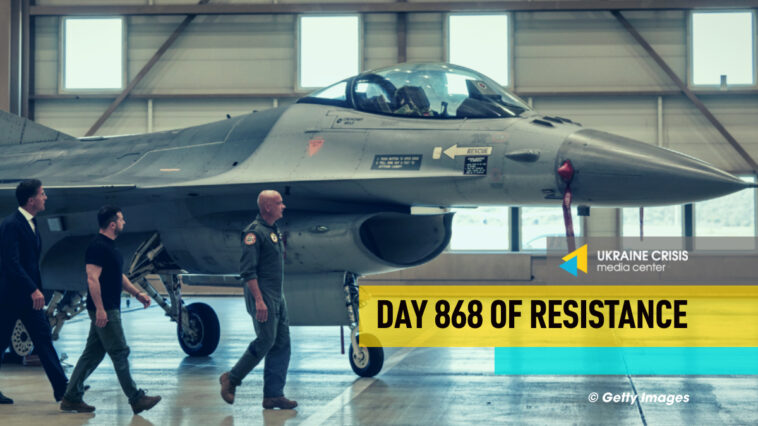Bellingcat’s analysis confirms that the weapon that struck the Okhmatdyt children’s hospital was a Russian launched Kh-101 cruise missile. President Zelenskyi on F-16s: we’re waiting for the jets like my mother used to wait for me to come home after school and I used to find excuses to come home late. Russia has lost more than 90 per cent of troops it committed to the Kharkiv offensive.
Bellingcat’s analysis confirms weapon that struck Okhmatdyt hospital was Russian launched Kh-101 missile
An analysis by Bellingcat, a group that uses open sources and social media for investigations, has pointed to a Russian launched Kh-101 cruise missile being the weapon that struck the Okhmatdyt children’s hospital in Kyiv on July 8. The analysis is in line with the view of a number of missile experts. Analysts relied on video footage posted to social media shortly after the attack showing a missile impacting the hospital.
The missile exhibits several characteristics, including the presence of what appears to be a jet engine at its rear as well as two short wings near the middle of the missile. These are distinct features of the Kh-101, a cruise missile used exclusively by the Russian armed forces, Bellingcat said.
A comparison of a screenshot of the missile that hit the hospital with a 3D rendering of a Kh-101 missile shows that the two indeed share these features. A video overlay of the two images above also demonstrates the matching the features and proportions of the 3D model of the Kh-101 and the missile that hit the hospital.
In the aftermath of the strike, several social media accounts known for spreading disinformation — including that of the Russian Ministry of Foreign Affairs — began to claim that the missile could not be a Kh-101, but instead an AIM-120 fired from a Ukrainian NASAMS battery.
The claim that the missile was an AIM-120 ignores the jet engine prominently hanging from the empennage of the missile that hit the hospital. This highly visible feature is present on the Kh-101, but not on the AIM-120. Furthermore, the wings in the mid-section of the missile that hit the hospital are a mismatch for those on an AIM-120.
Nevertheless, Bellingcat created a second 3D model to represent an AIM-120 missile to test this theory. When comparing this model to images of the missile that hit the hospital, factors like the forward fins of the AIM-120 not matching were apparent. Additionally, the nose of the AIM-120 is much sharper than that of the missile in the hospital strike video. Perhaps most noticeable is the absence of any component on the AIM-120 matching the jet engine seen at the rear of the missile in the video.
In a statement on Tuesday, Ukraine’s Security Service presented evidence showing that Russia had struck the Okhmatdyt hospital with a Kh-101 cruise missile.
Zelenskyi on F-16s: we’re waiting for the jets like my mother used to wait for me to come home after school and I used to find excuses to come home late
President Volodymyr Zelenskyi said he hoped the F-16 fighter jets that the allies promised were due to arrive this summer. Ukraine needs at least 128 jets to confront Russia.
In remarks at the Ronald Reagan Presidential Foundation and Institute on Tuesday night on the sidelines of the NATO summit in Washington, Zelenskyi said: “It’s like a discourse about F-16s. It’s like saying that it’s a great, powerful decision to give Ukraine F-16s. But what number? (…) We always wait. Just like my mother used to wait for me after school, and I always found a reason to come home later. It’s the same thing, only much more serious.”
When asked if Ukraine will get F-16s this summer, Zelenskyi said he hoped so. “The problem with F-16 [transfers] is the number and the dates. Russia uses 300 jets on the territory of Ukraine, 300 jets. They have more, but they use 300 jets. We have a decision about some 10, 20 [F-16s]. Even if we have 50, it’s nothing. They have 300. We need — because we are defending — we need 128, this is the fleet, all these numbers our partners have. So till moment when we will have 128 with them in the sky — anyway it will be difficult,” the Ukrainian President said.
Russia has lost more than 90 per cent of troops it committed to Kharkiv offensive
Russia deployed 10,350 troops in its new Kharkiv offensive that it started two months ago. Since then, Russia has lost 91 per cent of the forces deployed to the Kharkiv direction, deputy commander of the Operational-Tactical Group Kharkiv, Colonel Viktor Solimchuk told a news conference, according to the news site Army Inform.
As of early July, he estimated that 2,939 Russian soldiers had been killed and some 6,509 wounded. Forty-five have surrendered.
“The enemy has tentatively lost around 91 per cent [of their troops] in this direction,” Solimchuk said.
Since Russia renewed a push toward Kharkiv region, it has lost most of its 138th motor rifle brigade, and depleted the 83rd and 157th tank regiments.
Solimchuk said Russia’s 83rd air assault brigade is constantly taking losses that at times amount to dozens of soldiers a day.
In view of heavy losses, the Russian command has to move units from other sections of the front and deploy reserves. Yet Russia still has a serious offensive potential, Solimchuk added.
He said Russian forces were regrouping, rebuilding manpower and supply lines. They also train assault groups in the rear. Ukrainian troops are conscious of the potential Russia has in the area.
“Our service members, artillery and drones considerably derail the enemy’s plans. They are making unsuccessful attempts to step up their push and widen the area they control. We will continue to destroy the occupying forces all along the front lines and state border, ruining their invasion plans,” Solimchuk said.




